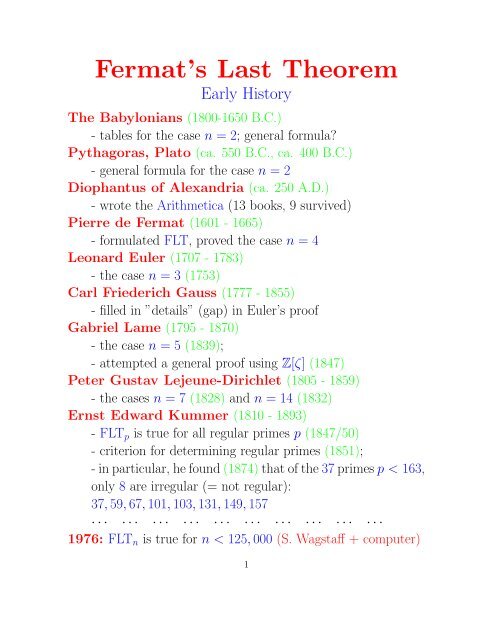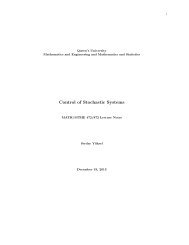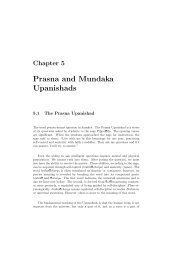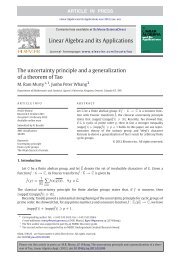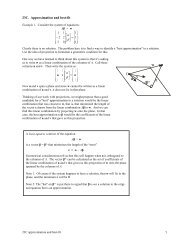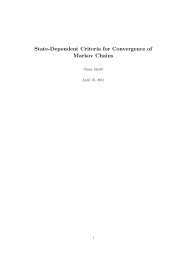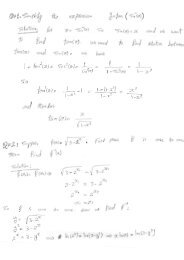Fermat's Last Theorem
Fermat's Last Theorem
Fermat's Last Theorem
You also want an ePaper? Increase the reach of your titles
YUMPU automatically turns print PDFs into web optimized ePapers that Google loves.
Fermat’s <strong>Last</strong> <strong>Theorem</strong><br />
Early History<br />
The Babylonians (1800-1650 B.C.)<br />
- tables for the case n = 2; general formula?<br />
Pythagoras, Plato (ca. 550 B.C., ca. 400 B.C.)<br />
- general formula for the case n = 2<br />
Diophantus of Alexandria (ca. 250 A.D.)<br />
- wrote the Arithmetica (13 books, 9 survived)<br />
Pierre de Fermat (1601 - 1665)<br />
- formulated FLT, proved the case n = 4<br />
Leonard Euler (1707 - 1783)<br />
- the case n = 3 (1753)<br />
Carl Friederich Gauss (1777 - 1855)<br />
- filled in ”details” (gap) in Euler’s proof<br />
Gabriel Lame (1795 - 1870)<br />
- the case n = 5 (1839);<br />
- attempted a general proof using Z[ζ] (1847)<br />
Peter Gustav Lejeune-Dirichlet (1805 - 1859)<br />
- the cases n = 7 (1828) and n = 14 (1832)<br />
Ernst Edward Kummer (1810 - 1893)<br />
- FLT p is true for all regular primes p (1847/50)<br />
- criterion for determining regular primes (1851);<br />
- in particular, he found (1874) that of the 37 primes p < 163,<br />
only 8 are irregular (= not regular):<br />
37, 59, 67, 101, 103, 131, 149, 157<br />
· · · · · · · · · · · · · · · · · · · · · · · · · · · · · ·<br />
1976: FLT n is true for n < 125, 000 (S. Wagstaff + computer)<br />
1
2. Observatio Domini Petri de Fermat<br />
Cubum autem in duos cubos, aut quadrato-quadratum in duos<br />
quadrato-quadratos, et generaliter nullam in infinitum ulta<br />
quadratum postestatem in duos ejusdem nominis fas est dividere;<br />
cujus rei demonstrationem mirabilem sane dexteri.<br />
Hanc marginis exiguitas non caperet.<br />
On the other hand it is impossible to separate a cube into two<br />
cubes, or a biquadrate into two biquadrates, or generally any<br />
power except a square into two powers with the same exponent.<br />
I have discovered a truly marvellous proof of this, which however<br />
the margin is not large enough to contain.<br />
[Translation: T. Heath]<br />
2
3. A Basic Principle<br />
Problem: Find all the integer solutions (x, y, z) ∈ Z 3 of the<br />
Diophantine equation<br />
(1)<br />
F (x, y, z) = 0,<br />
where F ∈ Z[x, y, z] is an integral polynomial.<br />
Examples:<br />
1) Fermat polynomial:<br />
F (x, y, z) = F n (x, y, z) = x n + y n − z n .<br />
2) Elliptic curve:<br />
F (x, y, z) = F a,b (x, y, z) = y 2 z −x 3 +axz 2 +bz 3 ,<br />
where a, b ∈ Z and ∆(F a,b ) = 16(4a 3 + 27b 3 ) ≠ 0.<br />
Easier Problem: For each prime number p, solve the congruence<br />
(2)<br />
F (x, y, z) ≡ 0 (mod p);<br />
this is a finite problem (for each p), for we need to check only p 3<br />
values. In particular, the number of solutions<br />
N ∗ p (F ) = #{(x, y, z) ∈ (Z/pZ) 3 : F (x, y, z) ≡ 0 (mod p)}<br />
= #{(x, y, z) ∈ Z 3 : 0 ≤ x, y, z < p and p|F (x, y, z)}<br />
≤ p 3 < ∞.<br />
Put: N p (F ) = (N ∗ p (F ) − 1)/(p − 1)<br />
= #of essentially distinct solutions of (2).<br />
Question:<br />
Do these numbers shed any light on the solutions<br />
of (1)?<br />
3
Basic (Conjectural) Principle: the sequence of numbers<br />
(3)<br />
a p (F ) def<br />
= (p + 1) − N p (F ), as p → ∞,<br />
should determine the nature of the solutions of (1).<br />
For elliptic curves, this principle assumes the form of two very<br />
precise conjectures which have been partly verified:<br />
(TWS)–Conjecture: - due to Y. Taniyama (1955), A. Weil<br />
(1967), and G. Shimura (1971)<br />
(B/SwD)–Conjecture: - B. Birch, H.P.F. Swinnerton–Dyer<br />
(1960’s)<br />
<strong>Theorem</strong> 1 (Kolyvagin(1988), Murty-Murty(1991) Let<br />
E : F a,b (x, y, z) = 0 be an elliptic curve satifying (TWS).<br />
Then the sequence a p (E) = p + 1 − N p (F a,b ), p → ∞, determines<br />
a (“computable”) constant L E (1) ∈ R. If<br />
L E (1) ≠ 0,<br />
then the equation F a,b (x, y, z) = 0 has only finitely many integral<br />
solutions (x, y, z) ∈ Z 3 with gcd(x, y, z) = 1, and these<br />
can be explicitly calculated.<br />
Note. The above theorem constitutes an explicit algorithm<br />
which has been implemented on a MAPLE package called APECS.<br />
Example (Frey). The above leads to a computer proof (a<br />
true proof!) of FLT 3 and FLT 4 , using only four short computer<br />
commands.<br />
4
4. The TWS–Conjecture<br />
To state this conjecture, we need two concepts:<br />
1) The conductor N = N E of an elliptic curve E: this is a<br />
positive integer<br />
N | ∆ a,b<br />
which is closely related to ∆ a,b (and is explicitly computable).<br />
2) The space S(N) = S 2 (Γ 0 (N)) of modular forms of level N:<br />
this consists of (complex-valued) functions of the form<br />
∞∑<br />
f(z) = a n (f)q n , with q = e 2πiz ,<br />
n=1<br />
where the a n (f) ∈ C and the sum converges for Im(z) > 0;<br />
these are to satisfy certain additional properties such as the rule<br />
( ) az + b<br />
f<br />
= (cz + d) 2 f(z),<br />
cz + d<br />
where a, b, c, d ∈ Z are any integers with ad − bc = 1 and N|c.<br />
Properties: 1) S(N) is a finite-dimensional C-vector space of<br />
dimension g N := dim C S(N) ≈ N 12 .<br />
2) Each f ∈ S(N) is uniquely described by its first 2g N ≈ N 6<br />
Fourier coefficients a 1 (f), . . . , a 2gN (f).<br />
3) S(N) has a distinguished C-basis H(N) = H + (N) ∪<br />
H − (N). The functions in H + (N) are called newforms, those<br />
in H − (N) oldforms. For each N, these forms are explicitly computable<br />
(and have been computed for N ≤ 10 6 ).<br />
5
Conjecture (TWS): For every elliptic curve E of conductor<br />
N, there is a (unique) newform f(z) = ∑ a n (f)q n ∈ H + (N) of<br />
level N such that<br />
(4)<br />
a p (E) = a p (f), for all primes p̸ | N.<br />
<strong>Theorem</strong> (Shimura, 1971). For each f ∈ H + (N) with<br />
integral Fourier coefficients there is an elliptic curve E (of<br />
conductor N) such that (4) holds.<br />
<strong>Theorem</strong> (Wiles, 1995). Conjecture (TWS) is true if N E<br />
is squarefree.<br />
6
5. TWS ss ⇒ FLT<br />
Suppose FLT p is false: there exist a, b, c ∈ Z with abc ≠ 0 such<br />
that<br />
a p + b p = c p .<br />
We may suppose (w.l.o.g.) that 2|a and that p ≥ 5. Consider<br />
the elliptic curve<br />
called a Frey curve. Then:<br />
1) ∆ = (abc) 2p<br />
y 2 z = x(x − a p z)(x + b p z),<br />
2) N E is squarefree (since 16|a p ).<br />
Thus, by Wiles’s theorem, there is an f = f E ∈ H + (N E ) such<br />
that (4) holds.<br />
Claim: Such an f E does not exist!<br />
<strong>Theorem</strong> (“Lowering the Level” - Ribet, 1991)<br />
Suppose f = f E ∈ H + (N) is a newform of level N. For<br />
a fixed prime number p > 3 let M p denote the product of<br />
the prime numbers q > 2 such that p|expt q (∆ E ). Then there<br />
exists g ∈ H + (N/M p ) such that<br />
a n (g) ≡ a n (f) (mod p), for all n ≥ 1 with gcd(n, N) = 1.<br />
Conclusion. Apply this to f E as above. Then by 1) we obtain<br />
that M p = N 2<br />
, so by Ribet’s theorem there is a newform g ∈<br />
H + (2). But this is impossible since dim S(2) = 0.<br />
7


